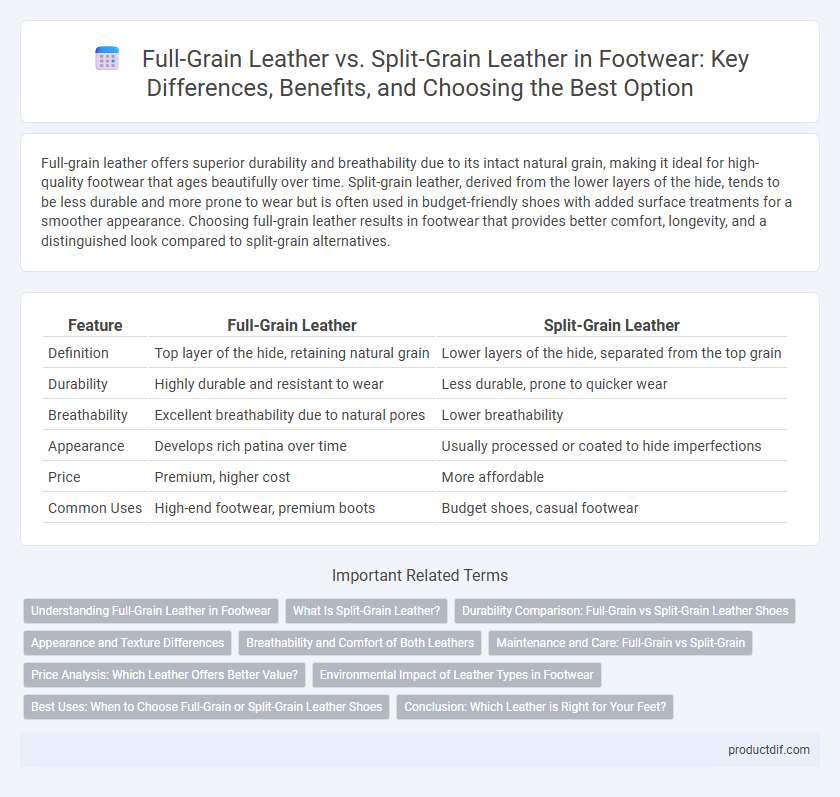Full-grain leather offers superior durability and breathability due to its intact natural grain, making it ideal for high-quality footwear that ages beautifully over time. Split-grain leather, derived from the lower layers of the hide, tends to be less durable and more prone to wear but is often used in budget-friendly shoes with added surface treatments for a smoother appearance. Choosing full-grain leather results in footwear that provides better comfort, longevity, and a distinguished look compared to split-grain alternatives.
Table of Comparison
| Feature | Full-Grain Leather | Split-Grain Leather |
|---|---|---|
| Definition | Top layer of the hide, retaining natural grain | Lower layers of the hide, separated from the top grain |
| Durability | Highly durable and resistant to wear | Less durable, prone to quicker wear |
| Breathability | Excellent breathability due to natural pores | Lower breathability |
| Appearance | Develops rich patina over time | Usually processed or coated to hide imperfections |
| Price | Premium, higher cost | More affordable |
| Common Uses | High-end footwear, premium boots | Budget shoes, casual footwear |
Understanding Full-Grain Leather in Footwear
Full-grain leather is the highest quality leather used in footwear, derived from the top layer of the hide, which retains the natural grain and imperfections. This type of leather offers superior durability, breathability, and develops a rich patina over time, enhancing the shoe's character and longevity. Unlike split-grain leather, full-grain maintains its strength and resistance to moisture, making it the preferred choice for premium, long-lasting footwear.
What Is Split-Grain Leather?
Split-grain leather is created by splitting the hide into layers, using the lower portion that lacks the dense fibrous structure of full-grain leather. This type of leather often features a corrected grain surface, which is sanded and coated to mask imperfections, resulting in a more uniform appearance. While less durable and breathable than full-grain leather, split-grain leather offers a cost-effective alternative commonly used in footwear linings and budget-friendly shoe uppers.
Durability Comparison: Full-Grain vs Split-Grain Leather Shoes
Full-grain leather shoes exhibit superior durability due to their intact natural grain layer, which resists wear and develops an attractive patina over time. Split-grain leather shoes, derived from the lower layers of the hide, lack this protective top layer and typically show faster signs of scuffing and aging. Investing in full-grain leather footwear results in longer-lasting performance and enhanced resistance to environmental stress compared to split-grain alternatives.
Appearance and Texture Differences
Full-grain leather showcases a natural, rich texture with visible grain patterns and slight imperfections, giving footwear a premium, rugged appearance that improves with age. Split-grain leather, created by splitting the hide, has a smoother, more uniform surface but lacks the distinctive grain texture, often resulting in a synthetic or suede-like feel. These differences in appearance and texture significantly impact the durability and aesthetic appeal of shoes made from each leather type.
Breathability and Comfort of Both Leathers
Full-grain leather offers superior breathability due to its intact grain layer, allowing air to circulate and moisture to escape, enhancing overall comfort. Split-grain leather, derived from the lower layers of hide, has a denser texture that restricts airflow, making it less breathable and potentially less comfortable over extended wear. Choosing full-grain leather footwear provides better ventilation and moisture management, which contributes to a more comfortable experience.
Maintenance and Care: Full-Grain vs Split-Grain
Full-grain leather requires minimal maintenance due to its durable and naturally resistant surface, often benefiting from regular conditioning to preserve its rich texture and prevent drying. Split-grain leather demands more frequent care and protective treatments because its fibrous inner layers are more porous and prone to damage from moisture and dirt. Proper cleaning with gentle products and consistent conditioning prolongs the lifespan of full-grain leather, while split-grain leather needs vigilant protection to avoid cracking and fading.
Price Analysis: Which Leather Offers Better Value?
Full-grain leather, known for its durability and natural texture, typically commands a higher price due to its superior quality and longevity. Split-grain leather, derived from the lower layers of the hide, is more affordable but less durable, often requiring replacement sooner. Evaluating cost-per-wear reveals full-grain leather offers better long-term value despite the initial investment.
Environmental Impact of Leather Types in Footwear
Full-grain leather, sourced from the top layer of the hide, tends to have a lower environmental impact due to its durability and longer lifespan, reducing the frequency of replacement. Split-grain leather, derived from the lower layers, often requires additional chemical treatments and finishes that can increase pollution and resource consumption in its production. Choosing footwear made from full-grain leather supports sustainable consumption by minimizing waste and lowering the overall ecological footprint associated with leather manufacturing.
Best Uses: When to Choose Full-Grain or Split-Grain Leather Shoes
Full-grain leather shoes are ideal for high-quality footwear that requires durability, breathability, and a natural aging process, making them perfect for formal and long-lasting casual wear. Split-grain leather offers a more affordable option suited for fashion-forward styles or shoes meant for occasional use, where flexibility and texture variety are desired. Choosing full-grain leather ensures investment in long-term comfort and patina development, while split-grain leather suits budget-conscious buyers prioritizing style diversity over longevity.
Conclusion: Which Leather is Right for Your Feet?
Full-grain leather offers superior durability, breathability, and natural aesthetics, making it ideal for those seeking long-lasting, high-quality footwear. Split-grain leather, while more affordable and flexible, tends to wear out faster and lacks the premium texture of full-grain leather. Choosing between the two depends on your priorities: invest in full-grain for resilience and style or select split-grain for budget-friendly, casual use.
Full-grain leather vs Split-grain leather Infographic

 productdif.com
productdif.com